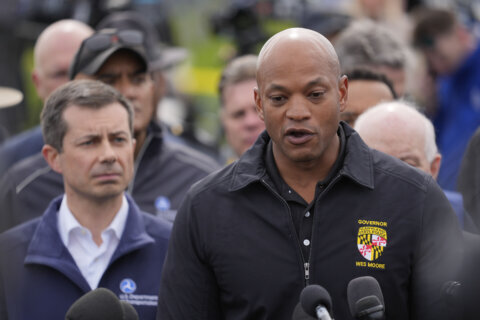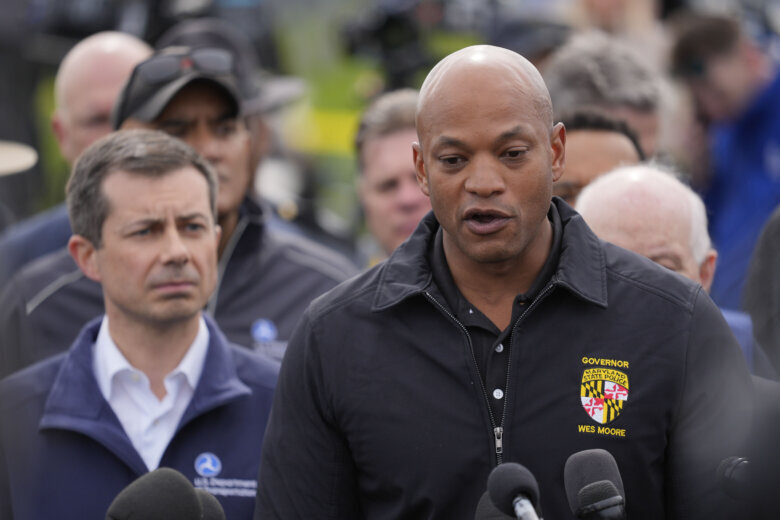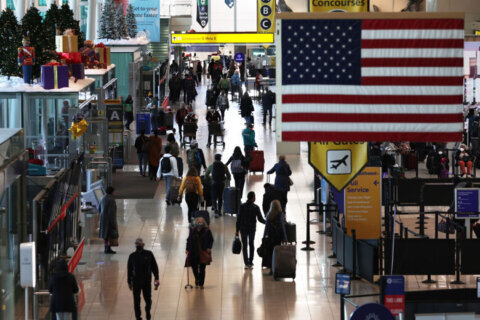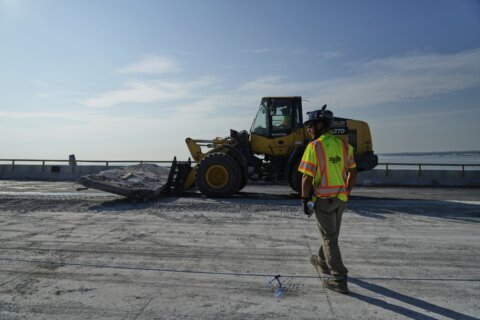Tuesday marks one week since tragedy forever changed the landscape in Baltimore and Maryland.

In the overnight hours last Tuesday, a huge container ship hit the Key Bridge causing most of it to fall like a deck of cards into the Patapsco River.
Six construction workers were killed in the collapse. Two bodies have been recovered — and four bodies are still trapped in the wreckage in the middle of the water.
The price tag for the recovery and to eventually rebuild the Key Bridge will likely be near $1 billion.
Maryland Gov. Wes Moore joined WTOP live from Dundalk, Maryland, to discuss the recovery efforts.
Listen to the full interview below. The transcript below has been lightly edited for clarity.
More on the Baltimore Key Bridge collapse
- Second channel opened allowing some vessels to bypass wreckage at the Baltimore bridge collapse site
- WATCH LIVE: Key Bridge removal, cleanup begins in Baltimore
- Financial help for small businesses affected by Baltimore Key Bridge collapse
- One of the last drivers to cross Baltimore’s Key Bridge, this man is ‘thankful’ to be alive
Anne Kramer: Joining us live from Dundalk right now is Gov. Wes Moore. Gov. Moore thanks for being with us this afternoon. It has been one week since the tragedy at the Key Bridge, how would you characterize what it has been like since you were told first about what happened?
Wes Moore: Thanks for having me. I think the the state is still in a sense of mourning. We still have six families who are living a nightmare right now and are just looking for closure. And I also think we’ve been able to see firsthand that our state is resilient, and that we’ve banded together. And I think we’re really showing what it means to be “Maryland Tough” and “Baltimore Strong” in this moment, where we know we have a long road ahead of us. We also know that even in just this past week, we’ve been able to show that progress is possible, as long as we’re willing to move in a collaborative fashion. So I think the state is still very much mourning. But I think we’re showing our resilience, as well.
Shawn Anderson: You’ve been very involved in the details of this effort. The first part of the bridge wreckage has been removed as each piece of steel and concrete comes out of the water. Where’s it all going? What is going to happen to this debris that you know?
Wes Moore: So the debris is going to get processed over at Tradepoint. And we’re thankful that all of all of our friends over Tradepoint have been able to use that as an assessment site for the steel that’s coming out. And we’re not talking about small pieces. Just a day ago, we were able to work to remove 200 tons of steel from the Patapsco. And just for people to get an understanding of what 200 tons is — 200 tons is the same weight of the Statue of Liberty. That’s what was removed a day ago. And so we continue to have operations where we’re working to open channels.
Right now we have two channels that are open — one has about a 10-foot draw, the other one has about a 14-foot draw. So we still know that there’s still quite a bit of work that needs to get done. Just for a sense of people to understand, in order to receive heavy vehicles, in order to keep cars, which is the largest revenue point for the Port of Baltimore, you need about a 35-foot draw. So there’s still more work that needs to be done. Our folks who are at Tradepoint are helping with the processing of the metal as it comes out of the water.
Anne Kramer: Governor, can you explain for our listeners why rescue crews cannot get to the bodies of the for construction workers.
Wes Moore: The complexity of this operation is unprecedented. There hasn’t been a maritime tragedy as complex as this one. Even when you look at what happened in Tampa, or you look at the bridge collapse in Minnesota. This one’s different because it’s not just a bridge collapse. You’re talking about a vessel, a ship, that is the length of the Eiffel Tower and that is the weight of the Washington monument that is sitting in the Patapsco River and is stuck there because there is a bridge that has 3,000 to 4,000 tons of steel that’s sitting on top of the vessel. So the measure of complexity on this is staggering.
And I think one thing people are seeing too is where the ship is stuck, you have depths of up to 50 feet inside of that area. And under the water, you have metal that is just completely broken and mangled. And so it’s a very dangerous situation for our divers, where literally as the divers are going into the water, you can’t see any more than a foot to 2 feet in front of you because of the amount of debris that’s currently sitting in the water. I am committed to making sure that we can bring a sense of closure to these families and a sense of comfort to the six families who literally are living a nightmare.
I also know that we have to prioritize and focus on the safety of our rescue and emergency personnel because we’ve already lost six Marylanders, and I’m not going to lose another one in this moment.
Shawn Anderson: Lot of curiosity about what happened with the workers in the moments before the bridge was hit. What can you tell us right now? Were they told in time the ship was going to hit the bridge? Did they try to drive off the bridge? Do we have any sense of what happened there?
Wes Moore: Well, we have a full NTSB investigation that’s taking place right now. And so we’re going to get answers. The thing that we’re driving is that we want it to be a speedy investigation. And then we’ll be able to have all the answers to the many questions that we have.
What we do know is that after the mayday was called in, and the ship notified emergency personnel that they were going to hit the bridge, to see the speed the first responders moved in, is just absolutely inspiring. We had first responders. We had MDTA, police, who then immediately sprung into action, who went and stopped other vehicles from going on the bridge. And by going on the bridge and stopping additional vehicles from going on the bridge, they saved countless lives because it wasn’t just the cars that they kept them going on the bridge, where it would have been an even more deadly situation.
What they did was they kept additional cars from driving off because remember, if that bridge would have collapsed, you still had cars that would have been coming up the Key Bridge at 40, 50, 60 miles an hour in the darkness, and wouldn’t have even realized that the bridge was gone. So they would have kept on driving. And so the amount of lives that were saved by our first responders, it really is a countless number. So a huge debt of gratitude that we owe to them.
Anne Kramer: Governor, transportation around Baltimore as a result. Tankers carrying hazardous chemicals can’t go into the harbor in the Fort McHenry tunnels. Without the Key Bridge, the drivers have to go around the Beltway or use those tunnels to get through the city. What’s happening now or is going to happen in the future to help to try alleviate some of the congestion that likely is going to happen, maybe even nightmares for drivers to experience in the coming weeks?
Wes Moore: Ever since last week, our Department of Transportation has been coming up with and sharing alternative routes for our drivers. And so that includes things like 895 and 95. For people that were coming off alternative usages for for the bridge because you’re absolutely right. There are over 36,000 individuals use the Key Bridge every single day. And so we’ve come up with alternative routes, tunnels, etc., that people can use to be able to get to where they get to. But we also know and we’re grateful for the amount of patience that people have given for us as we continue to adapt to this.
This is something that we know we’re going to have to come up with not just short- or medium-term solutions to it. Making sure that we are prioritizing that people can get to where they live and work and go to school in a quick and orderly fashion. And while we’re thankful for the patience, we also want people to know that the work is being done around the clock with our Department of Transportation to ensure that we can have an ease of transportation assets and pathways.
Shawn Anderson: Governor, President Biden will visit on Friday. We remember that the afternoon of the collapse, he pledged his intention for the federal government to pay the whole bill to rebuild the Key Bridge. But then a few days ago, Sen. Chris Van Hollen suggested that about 90% would be covered by federal dollars. Given that the state has a $3 billion deficit in the transportation fund already, how is the state going to come up with the remaining money to finish the job?
Wes Moore: Well, one thing we know is the support that we’ve received thus far from the Biden administration has been extraordinary. My first call with the White House, I think it was about 3 to 3:30 in the morning, the night of the tragedy. They have just been consistent partners with us throughout. When we put in the emergency funding requests, they came back with the initial $60 million that came with an hours, which was record time. So they’ve been wonderful partners in this.
But we do know that we are going to need congressional support. And the point that we’re making on this is — this is not just about Baltimore, and it’s not just about Maryland. The Port of Baltimore is the largest port in the country for new vehicles, for heavy trucks for agricultural equipment. So this is not just impacting Maryland. This is impacting the farmer in Kentucky. And this is impacting the auto worker in Ohio. And this is impacting the restaurant owner in Tennessee because the largest port for things like spices and sugars is the Port of Baltimore.
And so that’s why we know there has to be a partnership. And there has to be a shared responsibility when it comes to getting the Port of Baltimore back up and going, when it comes to getting the Key Bridge rebuilt. And when it goes to making sure that we don’t have an impact on not just Maryland’s economic engine, but this country’s economic engine because of supply chain shortages.
Get breaking news and daily headlines delivered to your email inbox by signing up here.
© 2024 WTOP. All Rights Reserved. This website is not intended for users located within the European Economic Area.








